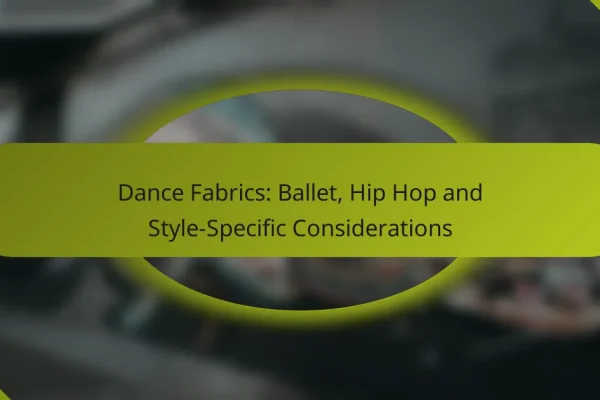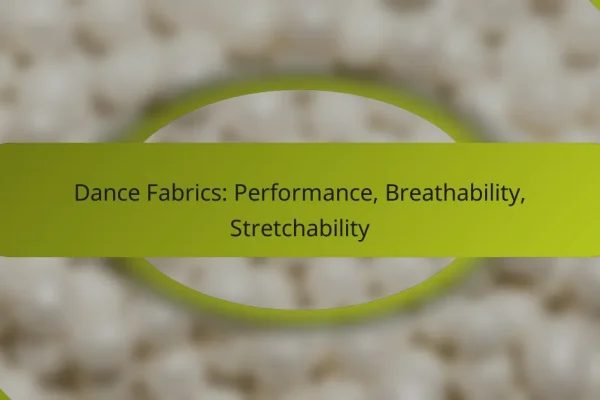What are the best dance fabrics for performance?
The best dance fabrics for performance are those that enhance movement, provide comfort, and withstand the rigors of dance. Key materials include spandex, polyester, nylon, cotton, and silk, each offering unique benefits tailored to different styles and preferences.
Spandex for flexibility
Spandex is renowned for its exceptional stretch and recovery, making it ideal for dancewear that requires a full range of motion. This fabric can stretch up to five times its original size, allowing dancers to perform dynamic movements without restriction.
When selecting spandex, look for blends that incorporate other materials for added support and breathability. A common choice is a spandex-lycra blend, which combines flexibility with durability, ensuring that the garment maintains its shape over time.
Polyester for durability
Polyester is a strong, resilient fabric that withstands wear and tear, making it suitable for frequent use in dance classes and performances. Its resistance to shrinking and stretching helps garments retain their fit, even after multiple washes.
Additionally, polyester often dries quickly, which is beneficial for dancers who may sweat during performances. When choosing polyester fabrics, consider options with moisture-wicking properties to enhance comfort during intense routines.
Nylon for moisture-wicking
Nylon is an excellent choice for dance fabrics due to its lightweight and moisture-wicking capabilities. This fabric effectively pulls sweat away from the body, keeping dancers dry and comfortable during performances.
For optimal performance, look for nylon blends that include spandex for added stretch. This combination provides both flexibility and moisture management, making it a popular choice for activewear and dance costumes.
Cotton for comfort
Cotton is a natural fiber known for its softness and breathability, making it a comfortable option for dancewear. It is particularly suitable for casual dance classes or rehearsals where comfort is a priority.
However, cotton may not provide the same level of stretch as synthetic fabrics. For better performance, consider cotton blends that incorporate spandex or polyester to enhance flexibility while maintaining comfort.
Silk for elegance
Silk is a luxurious fabric often used in dance costumes for its elegant drape and sheen. It adds a sophisticated touch to performances, making it a favorite for ballet and contemporary dance attire.
While silk is beautiful, it requires careful handling and maintenance. Dancers should be mindful of its delicate nature, opting for silk blends that offer added durability while preserving the fabric’s luxurious appearance.
How do I choose the right fabric for my dance style?
Choosing the right fabric for your dance style is crucial for comfort and performance. Consider factors like weight, durability, and stretch to ensure the fabric meets the specific demands of your dance genre.
Ballet requires lightweight fabrics
Ballet dancers benefit from lightweight fabrics that allow for ease of movement and breathability. Common choices include chiffon, tulle, and lightweight cotton blends, which provide a delicate feel while maintaining structure.
When selecting ballet fabrics, prioritize those that drape well and allow for fluidity in movement. Fabrics should not be too heavy, as this can restrict performance and hinder gracefulness.
Hip-hop needs durable materials
For hip-hop, durability is key due to the dynamic and often vigorous movements involved. Fabrics like cotton, polyester blends, and spandex are popular choices, offering both strength and flexibility.
Look for materials that can withstand frequent wear and tear while allowing for a full range of motion. Heavyweight cotton and canvas can provide the necessary durability without sacrificing comfort.
Jazz benefits from stretchable options
Jazz dance requires fabrics that offer excellent stretch and flexibility. Materials such as lycra, spandex, and jersey are ideal, as they allow for a wide range of motion and support various dance techniques.
When choosing jazz fabrics, consider options that fit snugly without restricting movement. Stretchable fabrics help dancers execute jumps and turns with ease, enhancing overall performance.
Where can I buy quality dance fabrics online?
You can find quality dance fabrics online at various retailers that specialize in fabric selection. Look for stores that offer a wide range of materials specifically suited for dancewear, ensuring you get the best options for your needs.
Joann Fabrics for a variety of options
Joann Fabrics is a well-known retailer that provides a diverse selection of dance fabrics. From stretchy spandex to soft cotton blends, you can find materials suitable for various dance styles.
Consider browsing their website or visiting a local store to explore seasonal sales and promotions. Joann often offers coupons, which can help you save on your fabric purchases.
Fabric.com for competitive pricing
Fabric.com is recognized for its competitive pricing on a wide range of fabrics, including those ideal for dancewear. Their online platform allows you to compare prices easily and find the best deals.
Look for bulk purchasing options or clearance sections to maximize your savings. They frequently update their inventory, so check back often for new arrivals and discounts.
Dancewear Solutions for specialized fabrics
Dancewear Solutions specializes in fabrics specifically designed for dance costumes and apparel. Their selection includes unique materials like sequined fabrics and performance mesh that cater to the needs of dancers.
When shopping here, pay attention to fabric descriptions to ensure they meet your performance requirements. Their knowledgeable staff can also assist with fabric choices if you have specific needs for your dance projects.
What are the key attributes of quality dance fabrics?
Quality dance fabrics are characterized by their breathability, stretchability, and colorfastness. These attributes ensure comfort, freedom of movement, and durability, making them essential for dancers who require reliable performance wear.
Breathability for comfort
Breathability is crucial in dance fabrics as it allows air circulation, helping to regulate body temperature during intense movement. Fabrics like cotton blends and moisture-wicking synthetics are often preferred for their ability to keep dancers cool and dry.
When selecting breathable fabrics, look for those with a lightweight structure and open weave. Avoid heavy materials that can trap heat and moisture, leading to discomfort during practice or performances.
Stretchability for movement
Stretchability is essential for dance fabrics to accommodate a wide range of movements. Fabrics with spandex or elastane blends provide the necessary elasticity, allowing dancers to execute high kicks, jumps, and intricate choreography without restriction.
Consider the fabric’s recovery as well; it should return to its original shape after stretching. This ensures that the garment maintains its fit and appearance over time, making it a worthwhile investment for regular use.
Colorfastness for longevity
Colorfastness refers to a fabric’s ability to retain its color after repeated washing and exposure to light. Quality dance fabrics should be resistant to fading, ensuring that costumes and practice wear look vibrant and new for longer periods.
To assess colorfastness, check for labels indicating resistance to washing and sunlight. Fabrics treated with dyes that meet industry standards are typically more reliable, making them a smart choice for dancers who frequently wash their gear.
How do I care for dance fabrics?
Caring for dance fabrics involves specific practices to maintain their quality and longevity. Regular washing, proper drying techniques, and careful storage are essential to keep these materials in optimal condition.
Washing dance fabrics
When washing dance fabrics, always check the care label for specific instructions. Generally, hand washing in cold water with a mild detergent is recommended to prevent damage. If machine washing is necessary, use a gentle cycle and a mesh laundry bag to protect delicate materials.
Avoid using bleach or fabric softeners, as these can degrade the fibers and alter the fabric’s texture. For best results, wash dance wear separately from other clothing to prevent snagging or color transfer.
Drying techniques
After washing, air drying is the safest method for dance fabrics. Lay the garments flat on a clean towel or hang them to dry in a shaded area, avoiding direct sunlight which can fade colors. If using a dryer, opt for a low heat setting and remove the items while still slightly damp to minimize wrinkles.
Never wring out dance fabrics, as this can distort their shape and elasticity. Instead, gently squeeze out excess water without twisting.
Storage tips
Proper storage of dance fabrics is crucial for maintaining their shape and quality. Store garments in a cool, dry place away from direct sunlight. Use padded hangers for items that can stretch, and fold heavier fabrics to prevent creasing.
Consider using garment bags for long-term storage, especially for delicate materials. Avoid overcrowding in closets to prevent crushing and ensure airflow around the fabrics.










